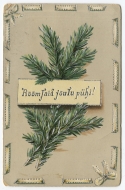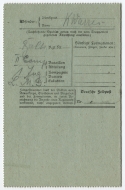Estonian War of Independence. November 1918 - February 1920
An important part of the establishment of the Estonian state in 1917–1918 has been played by the national army units, with whose support the idea of Estonian independence was realized. The national army units became the basis for the army of independent Estonia - thus the real forces necessary for our War of Independence were concentrated in the homeland and the foundation for the organization of the people's self-defense was laid.
In 2018, 100 years will pass since the beginning of the Estonian War of Independence. The museum's collection of postal history includes nearly 700 postcards sent during the war years with stamps used in various military units.
The first part of the exhibition takes us to the years 1917–1919:
- Establishment of Estonian national army units in 1917–1918
- Field post in the Estonian War of Independence in 1919
Old letters are part of our cultural and postal history. The exhibition focuses on postal history, ie stamp prints. But there is also exciting research for those interested in history and postcards.
Enjoy and watch!
Enjoy and watch!
In the toolbar, under the information button, you will find the stamp imprint text ( in italics ), historical background information and explanations about the image.


Tallinn School Student Battalion
The Tallinn School Student Company was made on the 16.12.1918.
On the 23.01.1919 according to the Chief of Internal Defense Ernst Põdder order Tallinn School Student Battalion was made from company, where was over 400 student, Ersnt Leithammel was made to the commander.
The Tallinn School Student Company was made on the 16.12.1918.
On the 23.01.1919 according to the Chief of Internal Defense Ernst Põdder order Tallinn School Student Battalion was made from company, where was over 400 student, Ersnt Leithammel was made to the commander.


Tallinn School Student 2. Company
15.12.1918 - the School Student Company was made in Tallinn, all high school students and trade school students in the last two grades had to join, also all technical, agricultural and art school students.
Linda stone in the lake Ülemiste, Reval (Tallinn), Eesti
Ploompuu publication, Tallinn
15.12.1918 - the School Student Company was made in Tallinn, all high school students and trade school students in the last two grades had to join, also all technical, agricultural and art school students.
Linda stone in the lake Ülemiste, Reval (Tallinn), Eesti
Ploompuu publication, Tallinn


Tallinn School Student Battalion / 2. Company
Tallinn school students were in the Kalevlaste battalion and on the armored trains no 1, 2 and 3.
On the armored train no 2 there was also the Estonian Art Society’s Tallinn School of Arts and Crafts' student Eduart Wiiralt.
Foto: Reval, General Commando (Toompea, Tallinn)
Tallinn school students were in the Kalevlaste battalion and on the armored trains no 1, 2 and 3.
On the armored train no 2 there was also the Estonian Art Society’s Tallinn School of Arts and Crafts' student Eduart Wiiralt.
Foto: Reval, General Commando (Toompea, Tallinn)


Tartu School Student Battalion
After freeing the Tartu city (by Kuperjanovians and armored trains no 1 and 3) on the 14.01.1919, a special reserve of schoolchildren was formed at the reorganized Defense League, what on the 15.05.1919 was renamed to Tartu School Students Reserve Battalion. The battalion commandor was the captain Elmar Saar from the 5. Company.
After freeing the Tartu city (by Kuperjanovians and armored trains no 1 and 3) on the 14.01.1919, a special reserve of schoolchildren was formed at the reorganized Defense League, what on the 15.05.1919 was renamed to Tartu School Students Reserve Battalion. The battalion commandor was the captain Elmar Saar from the 5. Company.


Partisan Battalion of Commander-in-Chief Kuperjanov
The official birthday of Kuperjanov Partisan Battalion is 23.12.1918 in Puurmani, when lieutenant Julius Kuperjanov got the permission to form the special partisan battalion from the colonel Ernst Limberg, who was then the commander of the 2nd division.
The official birthday of Kuperjanov Partisan Battalion is 23.12.1918 in Puurmani, when lieutenant Julius Kuperjanov got the permission to form the special partisan battalion from the colonel Ernst Limberg, who was then the commander of the 2nd division.

Partisan Battalion of Commander-in-Chief Kuperjanov
On the 31.01.1919 Julius Kuperjanov was fatally wounded in the Battle of Paju. He did not get on the sanitary train until the night of the 1.02.1919, and on the 2.02.1919, Kuperjanov died of his wounds in the second Tartu military hospital (Aia tn 38).
On the 31.01.1919 Julius Kuperjanov was fatally wounded in the Battle of Paju. He did not get on the sanitary train until the night of the 1.02.1919, and on the 2.02.1919, Kuperjanov died of his wounds in the second Tartu military hospital (Aia tn 38).
Exhibition committee
Compiler: Eve Aab
Consultant: Ants Linnard, Chairman of the Postal Museum Friends Association
Photos: Arp Karm
Editor: Tuuli Kaalep
Toimetaja: Tuuli Kaalep
Compiler: Eve Aab
Consultant: Ants Linnard, Chairman of the Postal Museum Friends Association
Photos: Arp Karm
Editor: Tuuli Kaalep
Toimetaja: Tuuli Kaalep
References and sources
- Andreller, Jüri, Eduard Laaman and Johannes Poopuu. Armored Trains Division in the War of Independence. Tallinn Grenader, 2009.
- Estonian War of Independence XI.1918 - II.1920. Health care part. Tallinn, 1921.
- Estonian War of Independence 1918–1920. Parts I to II. Popular scientific publication of the Commitee on the History of the War of Independence. Tallinn Committee on the History of the War of Independence, 1937.
- Grosschmidt, Eduard. Under the skull mark. Tartu K / Ü Loodus, 1935.
- Guide to collecting materials from the history of the War of Independence. Chronology of events in the struggle period of Estonian national independence 1917–1920. Tallinn Committee on the History of the War of Independence, 1936.
- Kurvits, Oskar (ed.). Album of Estonian National Armed Forces II. Tallinn Society „1. Estonian Brigade” edition, 1937
- Kurvits, Oskar. Creation of Estonian national army units 1917–1918. Society „1. Estonian Brigade ”publishing house, 1930.
- Reinvaldt, Edvin and Tõnis Kint (assembly). Wide gauge armored train no. 2 In the War of Independence. Stockholm Foreign Estonia & EEA, 1972.
- Traksmaa, August.A brief history of the War of Independence.Tallinn: Publication-Private Limited Company "Cultural Community", 1939.



















